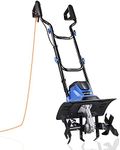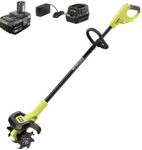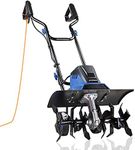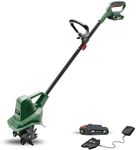Buying Guide for the Best Electric Tillers
Choosing the right electric tiller can make gardening and soil preparation much easier and more efficient. Electric tillers are ideal for small to medium-sized gardens and are known for being lightweight, easy to start, and environmentally friendly compared to gas-powered models. When selecting an electric tiller, it's important to consider the size of your garden, the type of soil you have, and the specific tasks you need the tiller to perform. Understanding the key specifications will help you make an informed decision that best suits your gardening needs.Motor PowerMotor power in electric tillers is measured in amps and indicates the strength of the tiller. A higher amp rating means more power, which is important for breaking up tough soil or working in larger areas. For small gardens with loose soil, a tiller with a motor power of around 6 to 8 amps may suffice. For larger gardens or denser soil, consider a model with 10 to 12 amps. Choose a motor power that matches the size of your garden and the type of soil you will be working with.
Tilling WidthTilling width refers to how wide a path the tiller can cultivate in a single pass. This is important because it affects how quickly you can cover an area. A wider tilling width, such as 16 to 18 inches, is suitable for larger gardens, allowing you to cover more ground quickly. For smaller gardens or more precise work, a narrower width of 8 to 12 inches may be more appropriate. Consider the size of your garden and how much maneuverability you need when choosing the tilling width.
Tilling DepthTilling depth indicates how deep the tiller can dig into the soil. This is crucial for preparing the soil for planting, especially if you need to mix in compost or other amendments. A tilling depth of 6 to 8 inches is generally sufficient for most gardening needs. However, if you are working with particularly compacted soil or need to plant deep-rooted crops, look for a tiller that offers a greater depth, such as 10 inches. Match the tilling depth to the type of plants you intend to grow and the condition of your soil.
WeightThe weight of an electric tiller affects its ease of use and maneuverability. Lighter tillers, typically under 30 pounds, are easier to handle and transport, making them ideal for smaller gardens or users who may not want to manage a heavier machine. Heavier tillers, over 30 pounds, may offer more stability and power, which can be beneficial for larger areas or tougher soil conditions. Consider your physical strength and the terrain of your garden when deciding on the weight of the tiller.
Corded vs. CordlessElectric tillers come in both corded and cordless models. Corded tillers offer continuous power as long as they are plugged in, making them suitable for gardens with easy access to power outlets. However, they can be limited by the length of the extension cord. Cordless tillers, powered by rechargeable batteries, offer more mobility and are ideal for larger gardens or areas without nearby power sources. Consider the layout of your garden and your preference for mobility when choosing between corded and cordless models.















